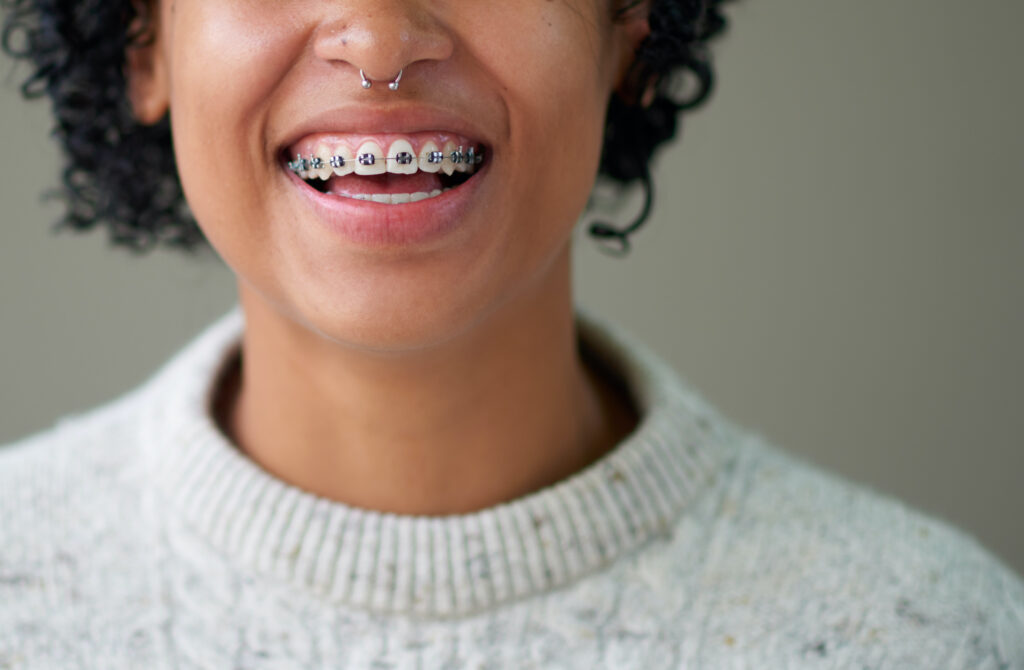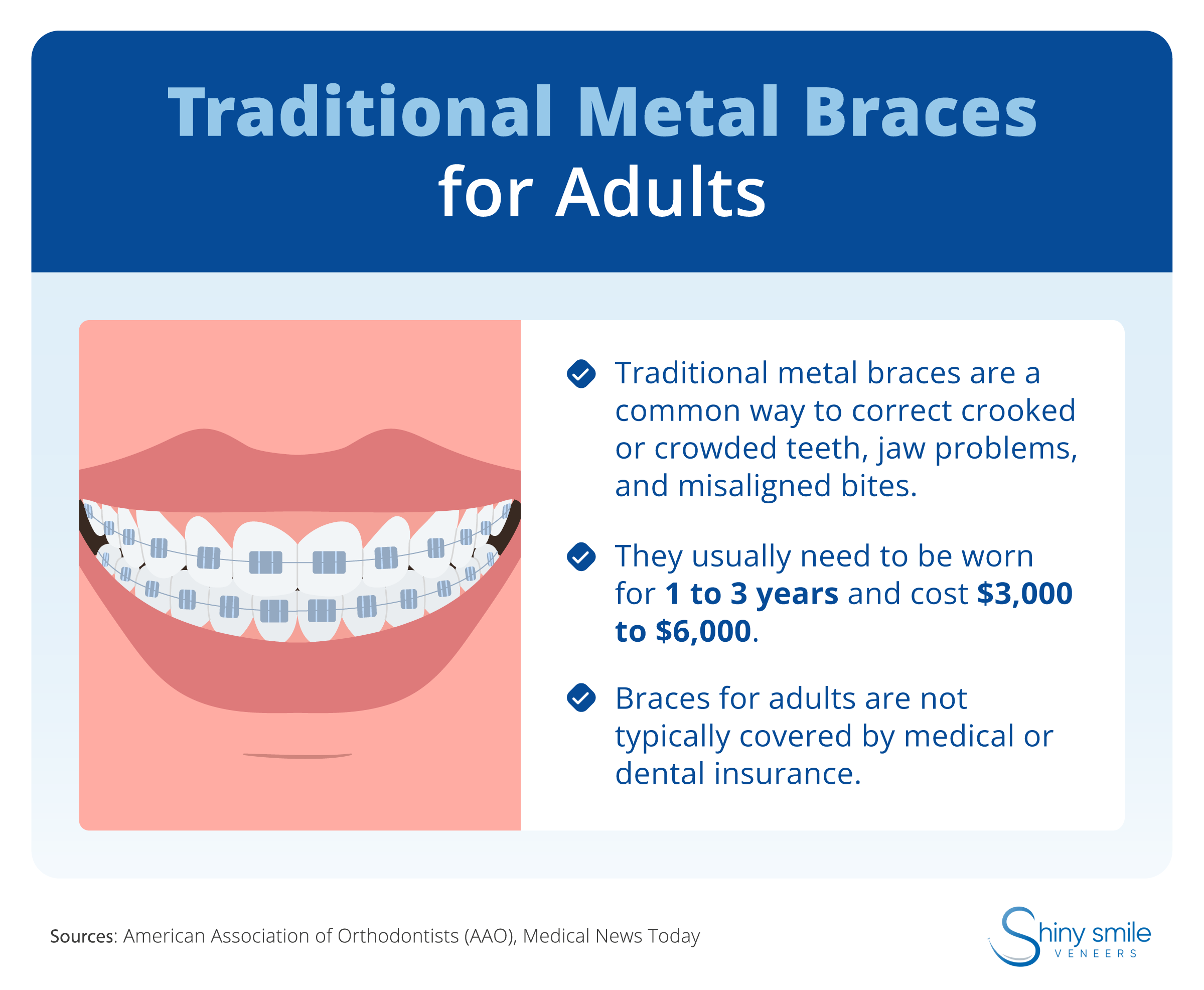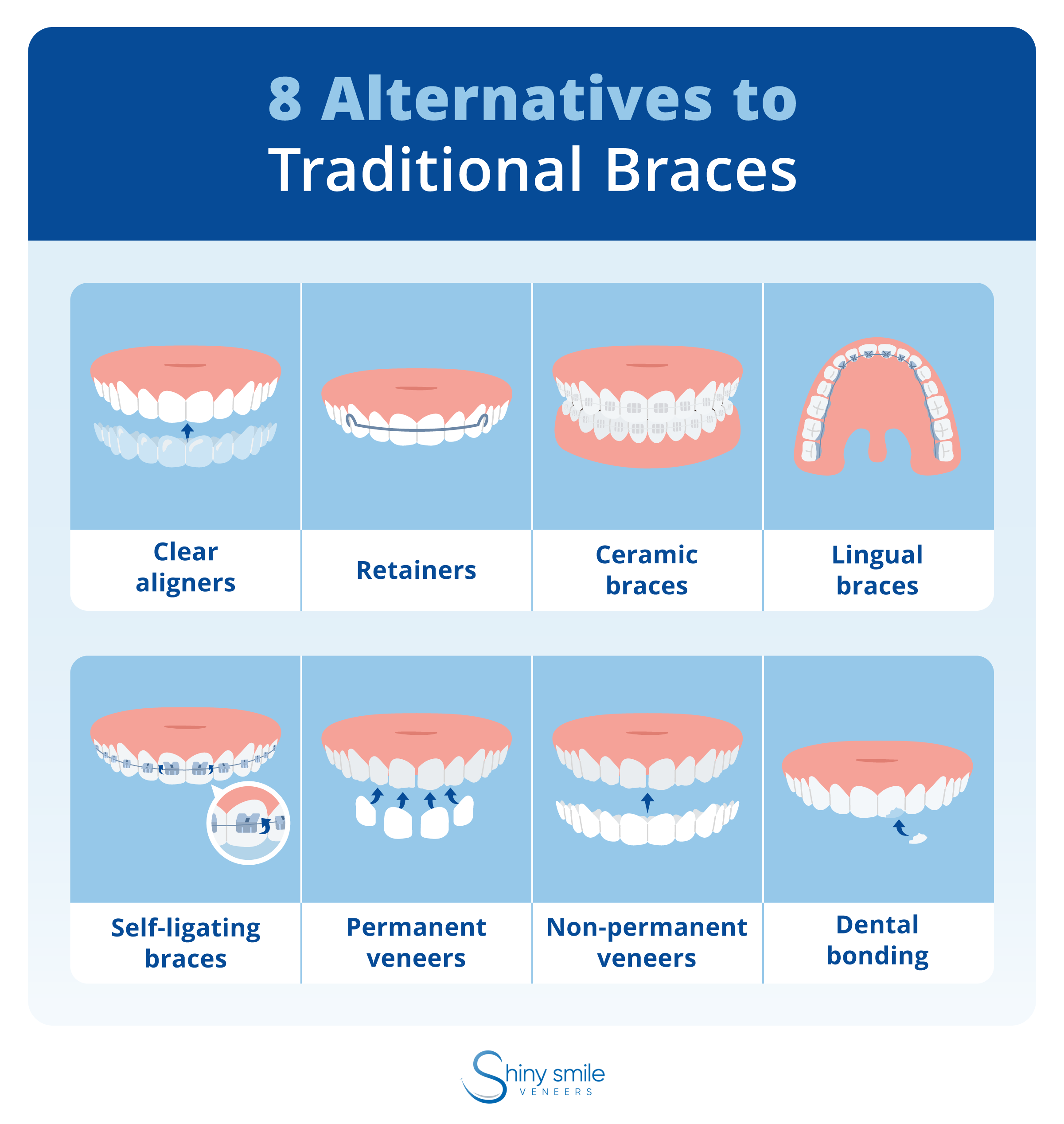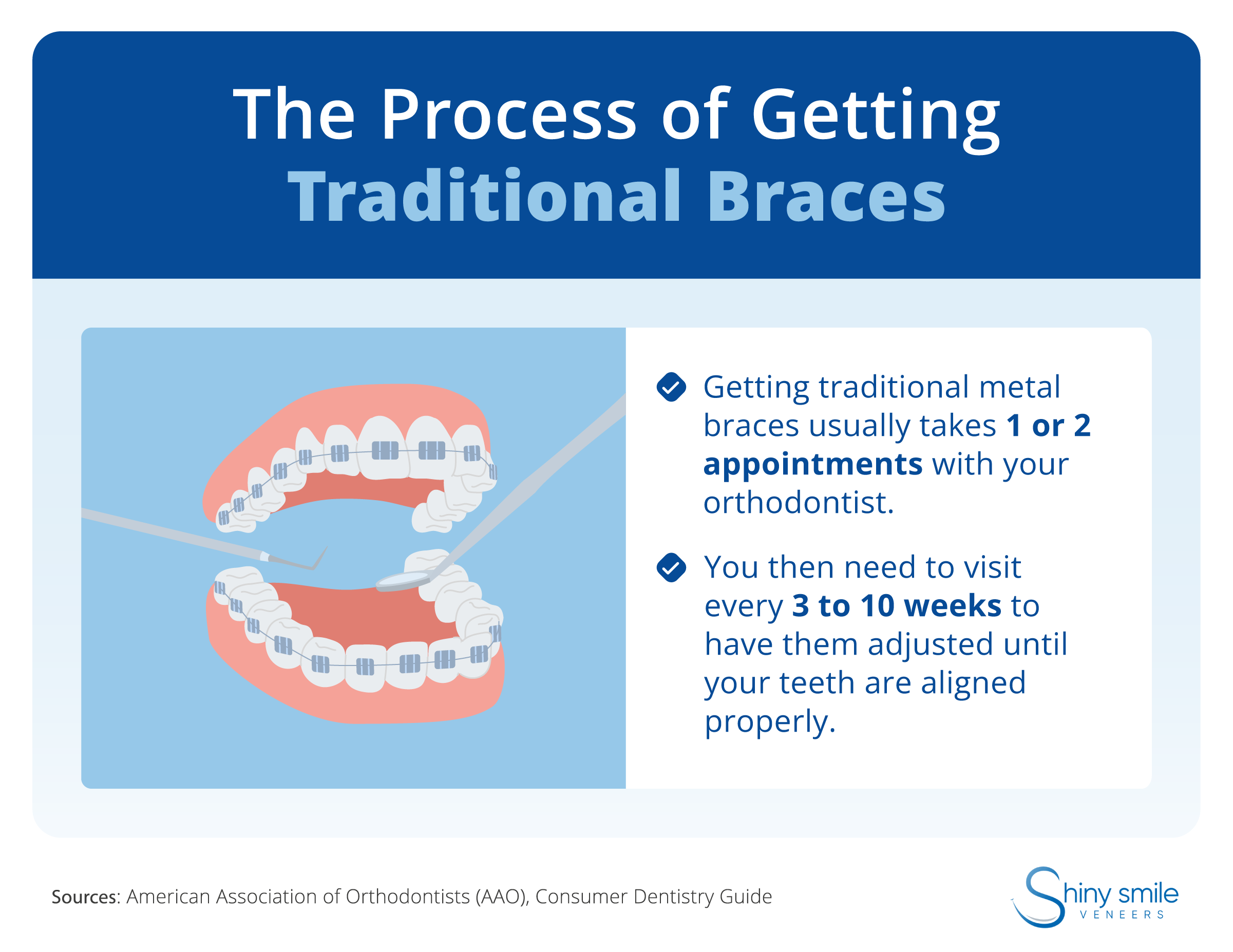
Braces are a common orthodontic treatment for both children and adults. They can correct a variety of dental issues. Your orthodontist may recommend braces if you have the following problems:
- Crooked teeth
- Crowded teeth
- Jaw problems, such as clicking or pain
- Bite irregularities (known as malocclusions), including overbites, underbites, and teeth that don’t line up properly
- Difficulty chewing, flossing, brushing, or speaking
- Missing or extra teeth
Traditional braces use metal brackets fixed to the front of your teeth with a horizontal wire that applies pressure to realign your bite. Fortunately, because of advancements in oral health, you can find alternative types of braces that are less noticeable and may be more comfortable, as well as other treatment options that your dentist may recommend depending on your dental issue.

Why Traditional Metal Braces May Not Be Right for You
While metal braces are effective for teeth alignment, the orthodontic treatment does have some downsides:
- Some people do not like the look of metal braces.
- Metal braces generally need to be worn for one to three years.
- Traditional braces can be expensive — typically costing $3,000 to $6,000 — and insurance policies don’t typically cover braces for adults (although it depends on your policy).
- When wearing metal braces, you may need to alter your diet to avoid sticky, chewy, or hard foods that could get stuck in or damage the braces.
- Metal braces may require more careful dental maintenance and additional cleaning with special toothbrushes or tools.
- You may find that alternatives to metal braces are less noticeable, require a shorter treatment time, are easier to care for, and may cost less.
8 Alternatives to Metal Braces
Popular alternatives to metal braces for adults include the following orthodontic and cosmetic dentistry options:

1. Clear Aligners (such as Invisalign)
Clear aligners (also called removable braces) are clear plastic trays that fit over your teeth. Less noticeable than traditional braces, they’re designed for people who don’t want to commit to a mouthful of metal. Common brands of plastic aligners include Invisalign, ClearCorrect, and SureSmile.
Clear aligners, like Invisalign move your teeth by applying a small amount of pressure. Although they can correct mild dental issues, plastic aligners may not make the best choice for more complex dental issues. A dentist will take impressions of your teeth to make a series of custom aligners, which you will receive at regular check-ups (every four to six weeks).
You must wear your clear aligners at least 20 hours a day, but treatment often takes less than one year to complete. After wearing the aligners for a year, you’ll likely need to use a retainer to stop the teeth from moving back to their original position. Initially, you may have to wear the retainer all the time, gradually decreasing until you only wear it at night.
Invisalign costs an average of $3,000 to $5,000 in the U.S., but the exact price will depend on your dental needs. If your insurance policy covers other types of orthodontic treatments like traditional braces, it may also cover plastic aligners.
- Pros: Clear aligners are less noticeable than traditional braces, you can remove them, they are easier to clean, and they have fewer potential problems (like detached brackets or broken wires).
- Cons: They are less effective than traditional braces for complex dental issues, you need to remember to wear them, and you must take them out when eating/drinking.
2. Retainers
Made of plastic or metal, retainers are small, custom-fit dental devices. They come in fixed and removable versions, with fixed retainers often used on the lower teeth and removable retainers used on the upper teeth.
The shape of dental retainers holds teeth in position. Dentists often recommend wearing a retainer after having your braces removed in order to keep your straight teeth in place. If you have only slightly crooked or crowded teeth, however, your orthodontist may recommend a fixed retainer instead of braces. For teeth that are only very slightly crowded, you may even have the option to use a removable retainer.
You will typically wear a retainer nightly for up to several years, depending on the severity of your dental issue, and to correct minor problems (as an alternative to braces), retainers usually cost $500 to $1,000 and may be covered by your insurance.
- Pros: Retainers are cheaper than traditional braces and only need to be worn at night.
- Cons: They can only fix minor dental issues.
3. Ceramic Braces
Although similar to metal braces, ceramic braces are less noticeable because they use tooth-colored or clear brackets rather than metal. For this reason, they are also known as “clear braces.”
Like traditional metal braces, ceramic braces use brackets and wires to apply pressure to your teeth. They also need to be fitted by an orthodontist. However, because ceramic is less durable than metal, they may be twice as likely to break than traditional braces (according to a study) and may require additional appointments to repair. Ceramic braces can also stain easily so you may have to take care to avoid food and drinks that cause discoloration.
Teeth straightening with ceramic braces typically takes one-and-a-half to three years, which is slightly longer than metal braces. Ceramic braces typically cost $4,000 to $8,000, which is slightly more than metal braces. Unless you have a separate orthodontic plan, ceramic braces are not typically covered by insurance.
- Pros: Ceramic braces are less noticeable than traditional metal braces.
- Cons: They may be more expensive but less durable than metal braces.
4. Lingual Braces
Although they have the same components as traditional braces, lingual braces are almost invisible because they are attached to the back of your teeth (known as the lingual side).
Lingual braces work the same way as standard braces by applying pressure to change your bite, except they’re fitted behind your teeth. Because the tongue may touch the device while making certain sounds, these braces may affect your speech at first, giving you a lisp. As your tongue gets used to it, however, your speech should return to normal.
You will typically need to wear lingual braces for the same amount of time as regular braces, perhaps a little longer. Lingual braces usually cost between $5,000 and $7,000, but the price may be higher. Unless you have a separate orthodontic plan, the cost of lingual braces is not usually covered by insurance.
- Pros: Lingual braces are as effective as regular braces while being almost invisible.
- Cons: They cost more and affect your speech temporarily.
5. Self-ligating Braces
Instead of using elastic or metal ties on the brackets to hold the archwire in place, self-ligating braces secure it with a built-in system using brackets or clips.
Self-ligating braces put pressure on your teeth much like traditional braces, but they may cause less discomfort and be easier to clean. Because adjusting self-ligating braces is less time consuming, they may also require shorter orthodontist visits.
You typically wear self-ligating braces for the same timeframe as traditional braces (one to three years). The price may be comparable to traditional braces ($3,000 to $6,000), or slightly higher depending on where you get them. Like other types of braces, self-ligating braces are typically not covered by insurance unless you have a separate orthodontic plan.
- Pros: Self-ligating braces may be more comfortable and require less maintenance than traditional braces.
- Cons: They may cost more than traditional braces.
6. Permanent Veneers
Dental veneers are thin coverings placed on the front surface of your teeth. Typically made of porcelain or composite resin, they are designed to conceal aesthetic imperfections such as gaps and misshapen teeth.
Instead of correcting your teeth using pressure, permanent veneers use custom-made shells to conceal the imperfections rather than fix them. Getting porcelain or composite veneers is an irreversible process because your dentist will remove some of your natural tooth enamel to place the veneers.
The treatment plan for traditional veneers requires at least two dental visits over several weeks to complete the process. However, this solution lasts for a long time. Porcelain veneers typically have a lifespan of up to 10 years or longer (studies show they may last up to 20 years) and composite veneers can last up to 5 years or longer.
Porcelain veneers cost around $925 to $2,500 per tooth, while composite veneers cost around $250 to $1500 per tooth.
- Pros: Permanent veneers can conceal minor cosmetic imperfections, require a shorter procedure compared to braces, and last for many years.
- Cons: Permanent veneers are expensive, the process is irreversible, and the veneers themselves eventually need to be replaced.
7. Non-Permanent Veneers
Temporary veneers (such as Shiny Smile snap-on veneers) fit over your existing teeth like a retainer or mouth guard to improve the look of your smile.
Similar to permanent veneers, snap-on veneers conceal dental imperfections instead of correcting them like braces. Unlike permanent veneers or braces, however, you don’t need to see an orthodontist or dentist to get temporary veneers. You choose the shade you want, use the impression kit to take a mold of your teeth, and send the impressions back to have the custom veneers made.
After you take impressions at home and send them back, the custom veneers arrive in two to five weeks. Snap-on veneers may last one to five years with regular use, or potentially longer depending on how often you wear them.
Non-permanent veneers have a significantly lower price point, with Shiny Smile veneers costing $570.
- Pros: Temporary veneers are much more affordable than braces, and you don’t need to see an orthodontist or dentist.
- Cons: While suitable for concealing minor imperfections, they won’t correct orthodontic or dental issues.
8. Dental Bonding
To cover small cosmetic issues, a dentist will apply a tooth-colored resin to your teeth and then harden it with a special light. Dental bonding can close spaces between teeth and repair chipping, but it does not correct misalignments like wearing braces does. Bonding is most suitable for areas of low bite pressure (such as the front teeth).
Dental bonding usually takes 30 to 60 minutes per tooth. The solution can last for 3 to 10 years. At a typical cost of around $100 to $400 per tooth, dental bonding is often cheaper than permanent veneers and braces. The treatment may be fully or partially covered by your insurance.
- Pros: Dental bonding may cost less than braces and require a shorter treatment time.
- Cons: The solution can only conceal minor aesthetic issues.
What to Expect When Getting Braces
Braces work by putting pressure on your teeth to slowly move them into the proper position over time. In addition to brackets and wires, your orthodontist may use additional appliances such as a palate expander, temporary anchorage devices, and rubber bands to speed up the process or improve the result.

Getting braces usually requires one or two orthodontist appointments. At the first visit, you’ll have a consultation where you will have an x-ray taken of your teeth. This will help determine whether your condition is serious enough for braces, and if so, which type will work best, as well as how long you’ll need to wear them. At the next appointment, the orthodontist will fit your braces, which may cause you some discomfort for up to six hours afterward. Once the braces have been placed, you’ll need to visit your orthodontist every 3 to 10 weeks to have them adjusted until your teeth are aligned properly.
How to Choose Which Braces Alternative Is Best for You
Considered the traditional approach, metal braces have been shown to work and are trusted even for complex cases. Your orthodontist will evaluate your bite and other factors to determine the best appliance for you. Depending on the severity of your issue, budget, and desired outcome, you may be able to choose from a range of dental solutions. If your issue is minor or aesthetic only, you may be able to enhance your smile without braces or orthodontic treatment.
Snap-on Veneers May Be a Cheaper Alternative to Braces
If you find the appearance or discomfort of metal braces unappealing, you can choose from several alternatives to treat or conceal imperfections in your teeth. The best alternatives to braces for you depend on your specific dental issues, your budget, and the outcome you want.
To get a perfect smile without visiting an orthodontist, Shiny Smile offers custom-made snap-on veneers that fit easily over your teeth. You may find this a convenient alternative to wearing braces in the case of minor cosmetic issues, such as small gaps or discoloration. You can order and fit Shiny Smile Veneers right at home using a kit. At a cost of only $570 and a lifespan of one to five years with regular use, snap-on veneers offer an affordable way to restore your confidence in your smile.
